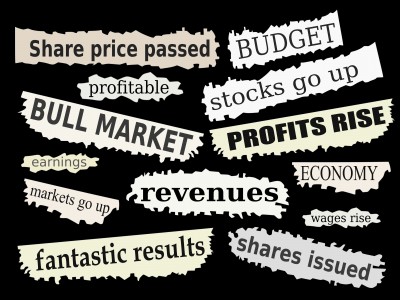The first thing you need to know about stock price changes is that the short-term stuff is generally unknowable.
This is the stuff that the newspapers and television programs and web sites focus on. Stocks went up. Stocks went down. Stocks slept in. Stocks wore a tie and shirt that didn’t match. Stocks got annoyed with the paparazzi. Stocks stayed up too late and suffered a meltdown. Stocks got bored and changed the channel.

Stocks don’t do anything. Stocks just sit there. We do stuff. We tell stocks what to do and stocks jump. We have the power!
This is an important point. It is how we feel about stocks that determines how stocks do in the short term. Our feelings are unpredictable. You say yes, I say no, you say stop, and I say go, go, go. You don’t want to be putting money down on a guess as to how stuff like that is going to turn out.
Short-term price changes mean nothing. Don’t waste your time reading about that stuff. It eats up your brain cells. The more you know about the short-term stuff, the less you know about the stuff that matters, the long-term stuff. It is the economic realities that control the long-term stuff. Paying attention to the short-term stuff causes you to start thinking about stocks in a way that makes it difficult to understand the long-term stuff.
My friends at the Vanguard Diehards board have a phrase they use to sum this up: “I don’t know and I don’t care” about the short-term stuff. That’s it. That’s the attitude that you want to adopt.
The second thing you need to know about stock price changes is that it’s probably not worth your time to do what it would take to learn the little that is knowable about the short-term stuff.
There are a few exceptions to what I said above.
Some time back I used to visit a discussion board at the PrudentBear.com site. There was a fellow there named “MannFM” who was smart as the dickens and who would from time to time write long posts describing an approach he used to predict short-term price changes. He would usually identify more than one possibility and ascribe rough probabilities to each of the possibilities identified. That strikes me as being a sensible way of going about what he was trying to do.
I don’t know if it works or not. The guy was smart. What he said made some sense to me. My guess is that it doesn’t work. But if you are willing to put lots of time and effort into checking it out, it’s possible that you will obtain a financial reward for doing so. I cannot rule out the possibility.
Most of us don’t have available to us the time it would take to check out something like this in the way we would need to check it out to justify putting money down on it. And we don’t need to. Solid investing returns are available to those who make no effort whatsoever to understand what is going on with short-term stock price changes. So my take is that it’s not worth messing with.
There’s no quick and easy way to profit from following short-term stock price changes. If you are going to take this path to investing success, you need to make a serious commitment to the project. Otherwise, direct your energies elsewhere. Putting a halfhearted effort into understanding short-term stock price changes is far more likely to hurt you than to benefit you. Let it be.
The third thing you need to know about stock price changes is that there is great value in knowing the long-term stuff.

The long-term stuff is different. The time it takes to understand the long-term stuff is minimal. The payoff is big. This is where the action is.
In the long-term, stock prices are determined by the economic realities. The longer you go out, the more that is so.
Short-term stock price changes are determined by emotions and thus are unpredictable. Long-term stock price changes are determined by economic realities and thus are predictable. That’s the most important thing that I have learned about stock investing. It’s huge. Understanding the difference between how stocks work in the short term and how stocks work in the long term will help you solve dozens of investing riddles. Understanding this distinction, and the strategic implications that follow from it, is the key to becoming a confident and successful investor.
When you understand the long-term stuff, you will no longer be afraid of stocks. You will no longer be taken in by all the various cons. You will get it. You have limited time to devote to learning how to invest. Spend it learning about the long-term stuff.
The fourth thing you need to know about stock price changes is that most of the long-term stuff is to a large extent knowable.
It wouldn’t hurt to read the sentence in bold two or three times. I’ve been working as a reporter for 25 years and those words comprise the most important story I have ever reported. The long-term stuff is knowable. Most people don’t believe me when I say this. I’m not kidding. I mean what I am saying here.
People have the idea that stock returns are the product of some big Random Number Generator in the Sky. No! Stock returns are the product of economic growth. The U.S. economy is a strong and stable economy. It is possible to form pretty darn accurate assessments of how much economic growth we are likely to see over the next 10 years, or the next 20 years, or the next 30 years.
So it is also possible to form pretty darn accurate assessments of the sorts of stock returns we are likely to see over the next 10 years, or the next 20 years, or the next 30 years. No?
Yes!
Stock returns are predictable. Please review the material at the “Return Predictor” section of the site for details. Stock returns are predictable. You don’t need to hand over your money with no idea as to whether you are ever going to see it again or not. Stock investing is less risky than most people think. Stock returns are predictable.
Most investing “experts” don’t talk about this much. A good number don’t even know it. It’s important. It’s worth taking some time coming to understand why long-term price changes can be anticipated in advance and developing investing strategies aimed at taking advantage of this reality.
The fifth thing you need to know about stock price changes is that almost all actionable information is communicated in the P/E10 value.
My web site is the new kid on the block. The good people at Google World tend not to give lots of points to the new kid on the block. They employ all sorts of nefarious schemes to keep mention of the articles at this site buried in the results handed back to searchers looking for information on saving or investing or career growth. Drats! Curses! Life is so unfair!
There are some exceptions to the usual rule, however. Enter a search for the term “P/E10” and you will find articles from my site sitting there right at the top of the pile. It shouldn’t be that way!
I’m happy to be sitting at the top of the pile. I’m not going to be writing a letter of complaint to the good people at Google World. But I should not rank that high for that term. There should be thousands of sites competing for that term, and the ones who are more established should be knocking young upstarts like me down on our fat bottoms each time we dare make an effort to climb that hill. But it’s not like that. I rank high for the term “P/E10.” It’s a big old goofy world, just like John Prine argues.

The P/E10 valuation tool is a tool of great importance. P/E10 is the price tag of the S&P stock index. You wouldn’t think of buying a car or a house or even a banana without first looking at the price tag, right? Well, you shouldn’t think of buying shares in the S&P index without first checking out the P/E10 value that applies at the time you are planning to make the purchase. If you don’t check out the P/E10 value first, you are investing blind. You are uniformed. You do not know what you are doing.
There are lots of “experts” who don’t tell you to check out the P/E10 value before purchasing a stock index. What I say above goes for them too. They are advising blind. They are uninformed. They do not know what they are doing. That’s my sincere take on this one. If you prefer to go by what those other guys and gals say, please feel free to do so. I understand. If you come here for your investing advice, what you are going to hear is that P/E10 is the price tag of stocks. I think it is as important as important can be, and I’ve got to say it the way I’ve got to say it.
When the S&P index is at a P/E10 value of 14, stocks are priced well, and you can realistically expect to see very strong returns 10 years out. When the S&P index is at a P/E10 of 8, stocks are scary but priced to return absolutely mouth-watering returns presuming that the entire U.S. government does not go bust (an outcome that strikes a good number as a real possibility when we are at a P/E10 of 8). When the S&P index is at a P/E10 value of 29 (that’s where we stand in October 2007, when this article was posted), look out below!
Not in the short-term. I don’t know and I don’t care what is going to happen in the short-term. P/E10 is an extremely valuable tool for those investors smart enough to understand that it is by focusing on what drives long-term price changes that they get from where they are to where they want to go.
The sixth thing you need to know about stock price changes is that it is perfectly sensible to consider other information.
When I talk about the power of P/E10, people often enter moderate freak-out mode (Believe it or not, I’ve known one or two or two-hundred to enter Full and Complete Freak-Out Mode, but discussion of that sort of thing is for a different section of the site). They say: “But isn’t it possible that the U.S. economy will perform differently in the future than it ever has in the past?” Or they say: “But isn’t it possible that people will someday come up with a valuation tool even better than P/E10?” Or they say: “But don’t lots of people ignore this P/E10 jizz-jazz despite all that you say about it?”
The future could be different. There might someday be an even better tool. Lots of people ignore what I say. Lots.
Please feel free to look at things other than P/E10 in assessing for yourself the value proposition offered by stocks at any particular time. You pays your money and you takes your chances. That’s how the wonderful game is played.
I think that it’s the long-term that matters and I am convinced that P/E10 is the tool that provides the sharpest insights into what is likely to happen in the long term. But perhaps some others will put some good work into the project of finding new ways to skin the cat. Perhaps you and me and everyone else will learn from their efforts. That would obviously be a very good thing for all of us. Let’s all root for the possibility.
The seventh thing you need to know about stock price changes is that the hard part is acting on what you know.

You look into this P/E10 gizmo. You find out that the number today is 29. That’s bad. Real bad. What do you do?
If you’re like most people, you do nothing.
Man is a social animal. We like to do what others around us are doing. We don’t feel comfortable straying too far from the rest of the flock.
That’s reality. I can tell you what works (or at least what I believe works). I cannot change human nature and make you feel comfortable taking action based on what works.
That’s why stocks pay such a strong return. That’s why stocks are risky. Many people say that stocks are risky because of the volatile price changes characteristic of this asset class. I don’t buy it. Those who understand the long-term stuff can develop strategies that take care of the volatility problem. The killer is developing the emotional fortitude that permits you to stray from the flock when straying from the flock is what’s needed to get the job done.
When just about everybody thinks that stocks are really, really, really risky, stocks are as safe as they will ever be (because prices are so low that stocks are a can’t miss bet). When just about everybody thinks stocks are really, really, really safe, stocks are as risky as all get-out (because prices are so high that it takes huge economic growth just to get buyers back to zero). Stock investing plays with your mind. There’s no getting around it.
It’s one thing to use the historical stock-return data to learn how best to invest for the long term. It’s something different to act effectively in response to what you learn. Taking action in accord with what the data tells you is the hard part. That’s the step in the process at which most investors lose their way.
The eighth thing you need to know about stock price changes is that we all need to know more than we do.
We know a lot more about what we need to know than we think we do.
We don’t know everything we would like to know.
Both things are so.
The ninth thing you need to know about stock price changes is that you need to resist the urge to believe that good economic developments are goods news for stock investors.

There is a poster at the Vanguard Diehards board named “Oildog” who once made a point that I found compelling but not ultimately persuasive. Oildog pointed out that the last time valuations dropped to extremely low levels (the early 1980s), the long-term economic growth picture really did look terribly poor. He cited an analysis by Warren Buffett showing that profits were so low that it really was reasonable to believe that corporate profits from that point forward might be permanently lower than they had ever been before in U.S. history.
It’s true that short-term price changes are never entirely driven by emotion. What usually happens is that investor emotions cause the effect of real economic developments on stock prices to be exaggerated.
Say that economic growth drops so low for a year that a P/E10 value of 8 seems perfectly appropriate. Does that mean that stocks are not as much of a steal as the P/E10 number indicates? It does not. When a long-term investor buys stocks, he is not buying them for a single year. Thus, the economic picture for the year of purchase is of only limited relevance to the analysis he needs to be performing. Implicit in a P/E10 value of 8 is a widespread investor belief that economic growth will remain poor for long into the future. That is the fallacy that creates an opportunity for investors using the historical stock-return data to “see though” emotion-driven pricing errors.
Things are never as bad as they seem when things seem really bad. And things are never as good as they seem when things seem really good. Our human emotions cause us to exaggerate the long-term effect of both good and bad economic developments. Buy stocks objectively (by using the historical data as your point of reference) rather than emotionally (by following the lead of other investors, as reflected in the “expert” advice broadcast in the conventional media) and stock price changes will work to your benefit instead of to your detriment.
The tenth thing you need to know about stock price changes is that taking your focus away from actionable information will hurt you rather than help you.
The internet is a sea of information bits. Google phrases like “how to invest,” “buying stocks,” and “buy-and-hold” and you will have so much information delivered to you that it may be days before you are able to come up for air. Unfortunately, having easy access to all these information bits hasn’t made us better investors. If anything, it has made us worse investors.
The problem is that junk information gives you the illusion of knowing what you are doing without providing the reality. The trick is distinguishing junk information from the real thing. Good information is actionable. You need actionable information. You need to learn what matters. You need to develop a strong grasp of the essentials, and, if doing that leaves you with no time even to take notice of the less-than-essential stuff, then so be it.

Robert Shiller says in his book Irrational Exuberance that: “The ability to focus attention on important things is a defining characteristic of intelligence.” I agree. What Shiller says becomes more and more important as more and more information bits become easily available to us.
Some stock price changes are meaningful. Some are not. Do you know the difference? If not, what aspect of the stock investing project is it that you are directing the time to that you instead need to be directing to learning how to distinguish the meaningful stock price changes from the insignificant ones? Answer that one, and you are on your way to being as intelligent in your investing life as you already are in all other areas of life endeavor.
